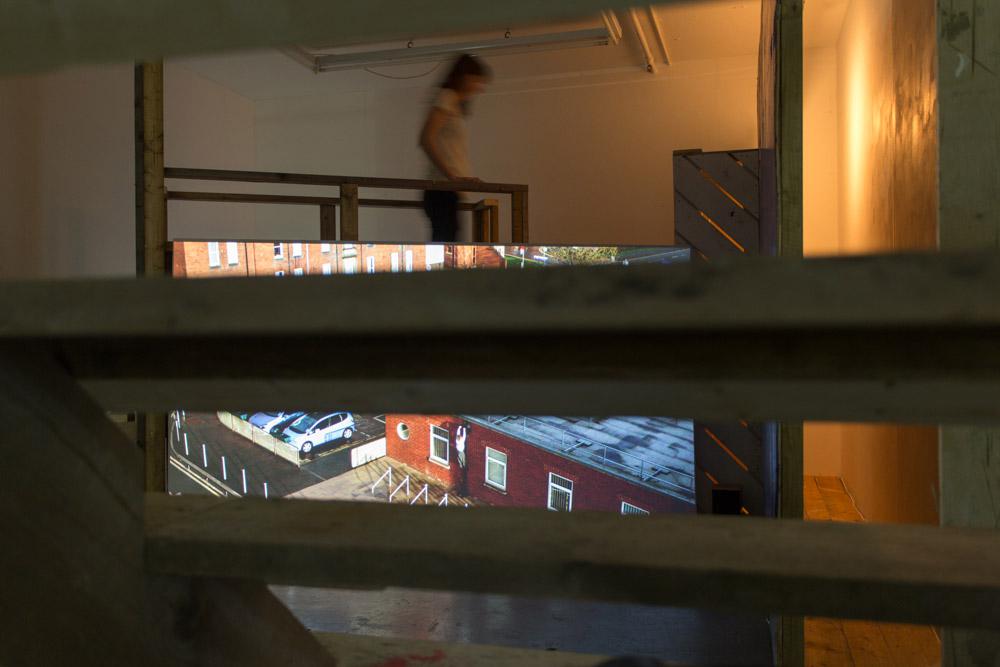In Toronto, the first city I learned my way around, an imposed grid organizes space into blocks and connects streets neatly at corners. In London, England, where Canadian curator Persilia Caton has recently relocated, moving through city spaces efficiently is a less linear negotiation, interrupted irregularly by winding medieval roads, cul-de-sacs and dead ends. Getting lost in any city, though, especially one you know well, is part of the everyday pleasure of urban life. It’s this sense of heightened awareness and renewed spatial vigilance—of gaps in and disruptions to auto-piloted pathways through well-travelled streets—that has inspired Caton’s exhibition “When the Grid Goes Soft” at MOT Projects.
The exhibition’s physical frame is provided by brothers Cedric and Nathan Bomford, originally from BC, who travelled to London to build a site-specific installation. The Bomfords’ intuitive construction process—like drawing with two-by-fours and mitre saws—works integrally and collaboratively to house a three-channel video piece by London-based artist Melanie Manchot and poster works by Berlin-based artist Jakob Kolding. Confined by the small space of the East End white cube, the show reinvigorates desire for the lost—or misplaced—consciousness of seeing and activating the cityscape.
In a way, the exhibition starts with the journey to find it. Located past iron gates and up a shabby exterior elevator, the MOT Projects space is in an industrial box containing studios, shops, offices and galleries. Trailing east from the bottom of Broadway Market, and running parallel with Regent’s Canal, it’s tucked away in the heart of a thriving East London neighbourhood somewhere between its industrial past and presently gentrifying forces. On one cold Friday afternoon in December dusk, the glow from a bank of Apple laptops in the window of a corner café and the blinking taillights of heavy construction vehicles along the canal lit the way.
Inside, the Bomfords have deconstructed and reconstructed the space in ways that play well against these familiar urban contrasts of making old new. It blocks off the usual entrance, so that visitors encounter a narrow space that echoes the width and purpose of a balcony outside. This buffers the series of planks, platforms, stairs and windows on and through which visitors can wander and watch within the larger main space. The materials around the projection—reclaimed raw wood, some of which was found already painted Yves Klein blue—make the space precarious, in process, like an abandoned construction site. But the carefully crafted architecture and modernist lines, which reverberate in Manchot’s videos and Kolding’s posters, also give it a certain aesthetic equilibrium.
Kolding’s posters, stacked in two neat piles on the floor in the bright anteroom to the darkened larger space, act as both visual signals to the exhibition’s theme and initial stumbling blocks. Kolding’s collages borrow film stills from The Loneliness of the Long Distance Runner, coupled with written instructions that imply and demand a coherent sense of spatial parameters: A Plan for Escape, reads one; take a run from the middle of the room to the wall, reads the other. They are apt prefaces to Manchot’s three-part video work, Tracer.
After navigating the posters, visitors can duck in behind the bleachers to access the labyrinth of city stages within and watch Manchot’s central projection, for which the bleachers serve as theatre seating. Tracer is the result of Manchot’s yearlong project with a team of parkour runners based in Newcastle, in the north of England. Part gymnastic, part dance and part sport, parkour derives from military obstacle-course training. Parkour runners like those in Manchot’s work—excerpts are viewable here and here—negotiate the built environment in a way that connects it fluidly to their bodies. The main projection, shot over four seasons, is incredibly graceful; subtle and exacting movements of the camera become a part of the collaboration as runners scale, run and jump in and through the city and the seasons.
Though devoid of still photography, the photographic haunts this exhibition. This is evident in Kolding’s film stills, most obviously, but also in the slow, sometimes nearly imperceptible movements of Manchot’s shots or of the actions that animate them. The Bomfords, both trained photographers, often use photographs in the research process for their built structures. As in past projects, here they interweave iconic features that call up the post-industrial “anonymous sculpture” so carefully and affectionately catalogued by Bernd and Hilla Becher with more contemporary city tropes like bleachers and hoarding.
And of course, in all of this, there’s a feeling for the revolutionary possibilities inherent in perceptual changes, the same optimism that imbued photographic modernism: a call for the beauty of the everyday, for functional architecture, for elegance and integrity in urban planning and in urban living.
In a time when the flâneur’s attention is trained on a slowly moving dot on a backlit screen, this exhibition reminds us to look up.









